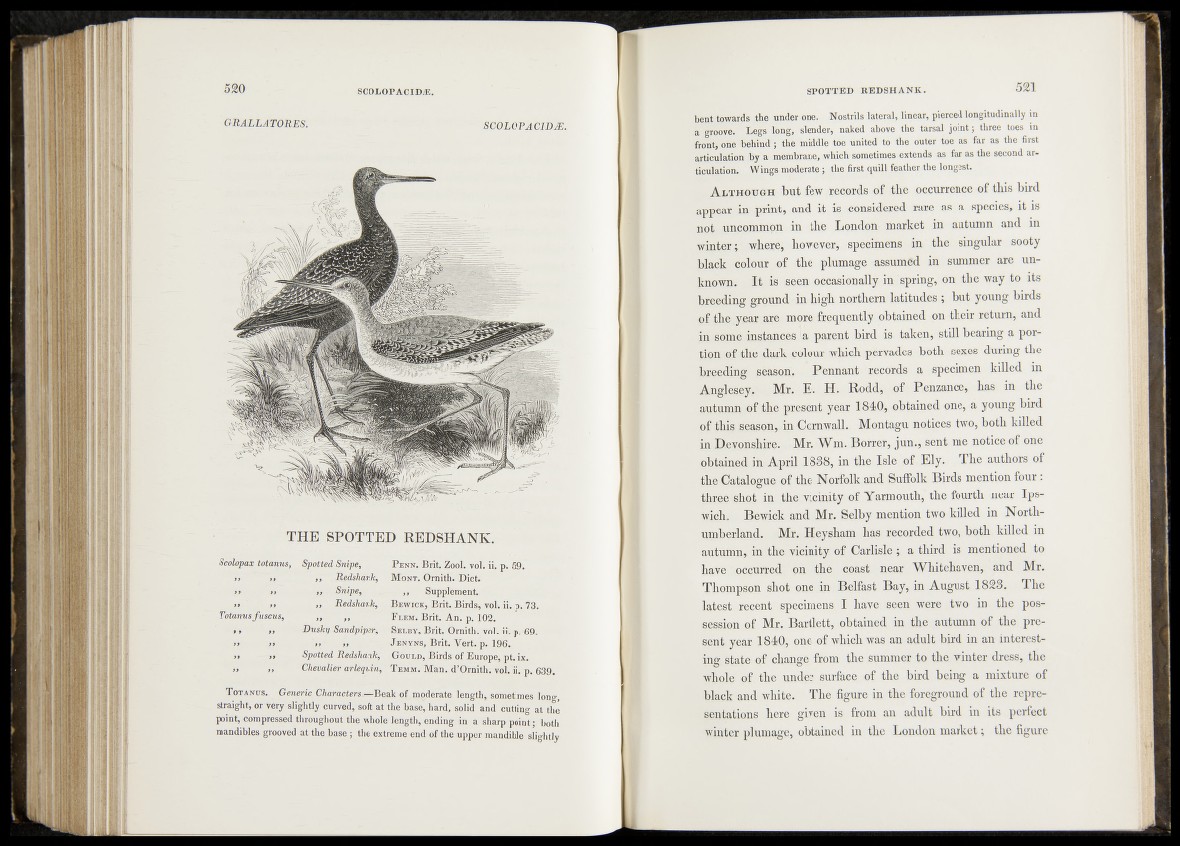
GRALLATORES. SCOLOPACIDÆ.
T H E SPOTTED REDSHANK.
Scolopax totanus, Spotted Snipe, P enn. Brït. Zool. vol, ii. p. 59.
Redshank, M ont. Ôrnith. Diet.
Snipej .— ,, Supplement.
» Redshank, B ewick, Brit. Birds, vol* ii. p. 73.
„ ,» F lem. Brit. An. p. T(Jâ.
-Dusky Sandpiper, Seeby, Brit. Omith. vol. ii. p, 69.
» „ J enyxs, Brit. Yert. p. 196.
Spotted Redshank,~ Gcôuld, Birds of Europe, pt. ix.
Chevalier arlequin, T e m m . Man. d’Ornith. vol.’ii. p, 639.
T otanus. Generic Characters.—Beak of_fipderate length, sometimes long,
straight, or very slightly curved, soft at the base, hard, solid and cutting at thé
point, compressed throughout the whole length, ending in a sharp point Vböth
mandibles grooved at the base; the extfeme end of the upper mandible slightly
bent towards the under one. Nostrils lateral, linear, pierced longitudinally in
a groove. Legs long, slender, naked above the tarsal joint; three toes in
front, one behind; the middle toe united to the outer toe as far as the first
articulation by a membrane, which sometimes extends as far as the second articulation.
Wings moderate; the first (giill feather the longest.
A l t h o u g h but few records of the occurrence of this bird
appear in print, and it is considered rare as a species, it is
not uncommon in the London- market in autumn and in
winter ; where; however, specimens in the singular sooty-
black colour of the plumage assumed in summer are unknown.
I t i^n.een occasionally in spring, on the way to its
breeding ground in high northern latitudes but young birds
of the year are more frequently .obtained on their return, and
in spni.e instances la parent bird is taken, still bearing a portion
;0f'the dark colour which pervades both sexes during the
breeding season. Pennant records a specimen killed in
Anglesey^. Mr. E. H. Rodd, of Penzance, has in the
autumn of the present year 1840, obtained one,-a young bird
, of this season, .in Cornwall. Montagu notices two, both killed
in Devonshire. Mr, Wm. Borrer, jun., sent me notice of one
obtained in April 1888, in the Isle, of Ely. . The authors of
the Catalogue of the Norfolk and Suffolk Birds mention four:
three shot in th,e vicinity of Yarmouth, the fourth near Ipswich.
Bewick and Mr. Selby mention two killed in Northumberland.
Mr. Heysham has recorded two, both killed in
autumn, in the vicinity of Carlisle; a third is mentioned to
have occurred on the coast near Whitehaven, and Mr.
Thompson shot one in Belfast Bay, in August 1823, The
latest recent specimens I have, seen were two in the possession
:/fi£ Mr. Bartlett, obtained in the autumn of the present
year 1840, oto,of which was an adult bird in an interesting
state of change from the summer to the winter dress, the
Whole of the under surface of the bird being a mixture of
black and-wbitj.;? The figure in the foreground of the representations
here given is from an adult bird in its perfect
winter plumage, obtained in the London market; the figure